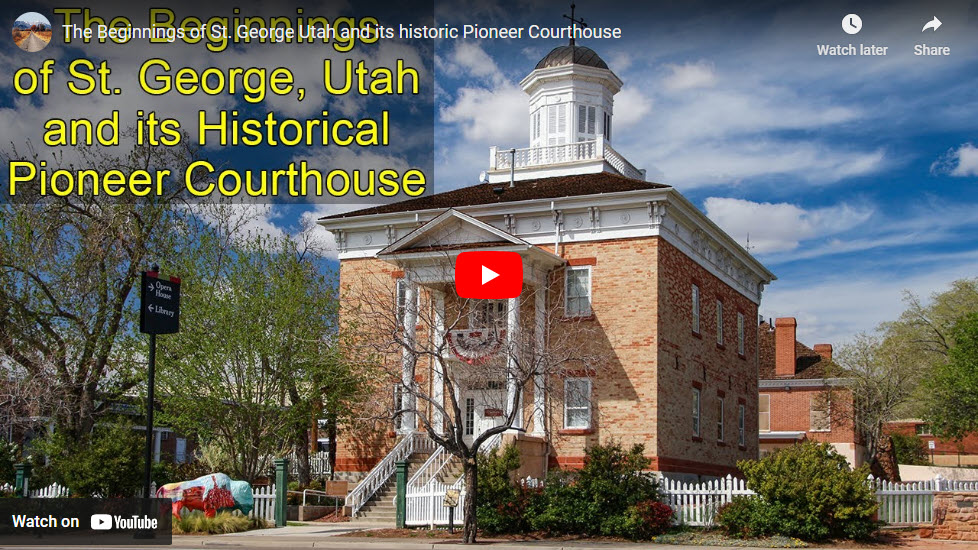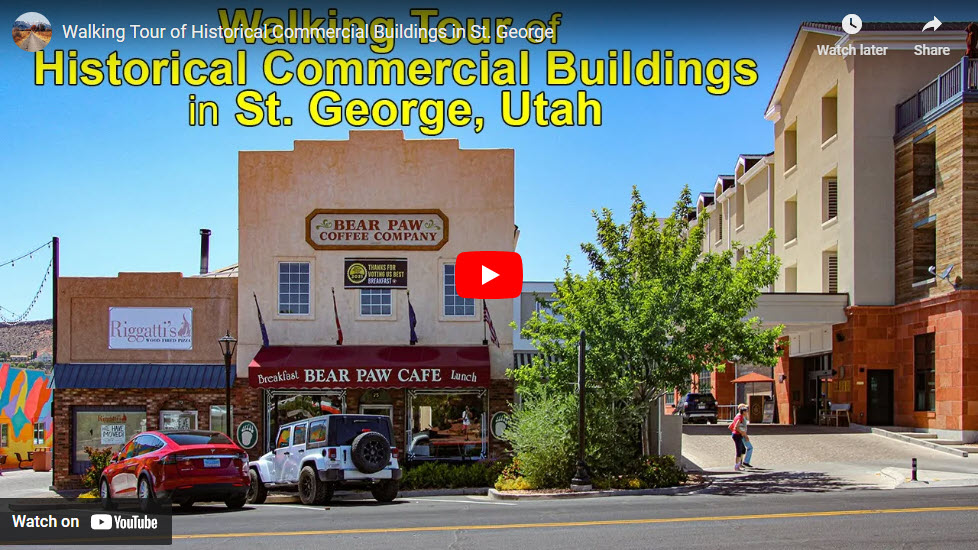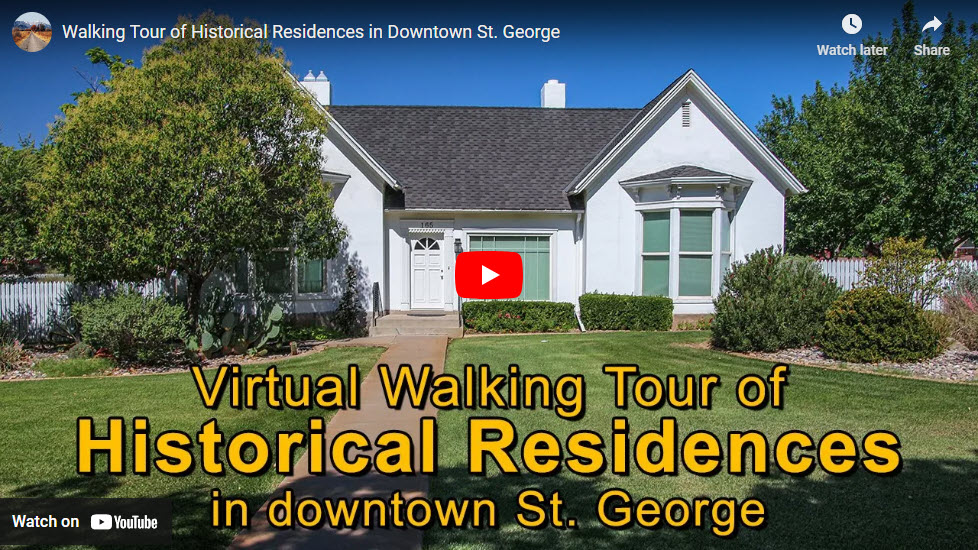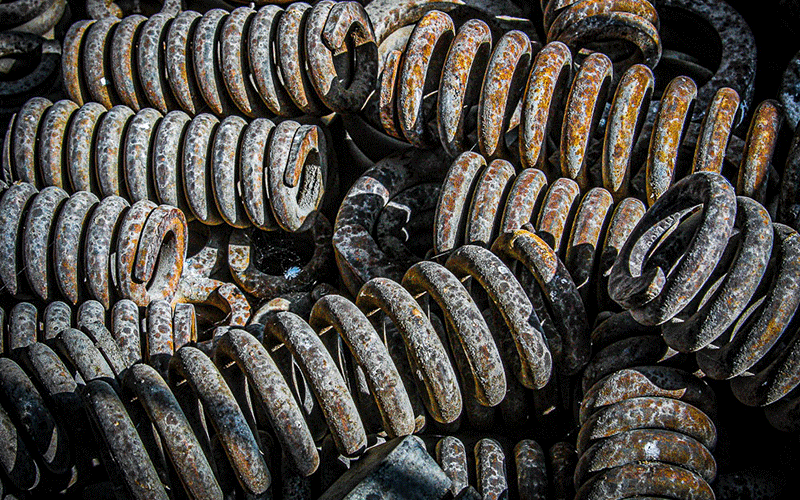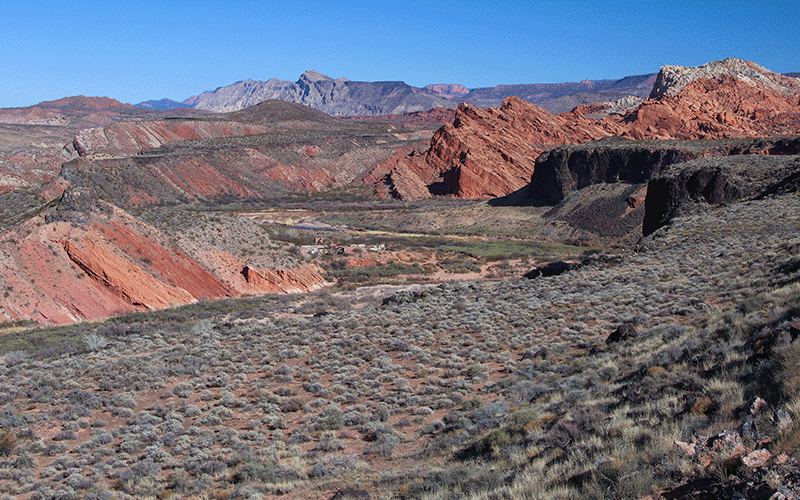St. George Historical Walking Tour
In the heart of downtown St. George sits the Pioneer Courthouse, a historical building that was the cornerstone of this once young and emerging community. The following article will explain how the Pioneer Courthouse came into being, along with detailing a walking tour to nearby historic buildings in St. George.
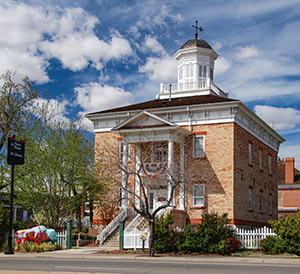
In This Article
- Videos
- Pioneer Courthouse Tour
- Walking Tour of Commercial Buildings
- Walking Tour of Residential Buildings
- The Layout of St. George
- Pioneer Courthouse
- Walking Tour Description
- Map of Walking Tour
Videos
Below are the three videos on YouTube that cover the tours.
Pioneer Courthouse & History of St. George
Take a virtual tour inside the Pioneer Courthouse and learn how and why downtown St. George was laid out the way it is today.
Walking Tour of Commercial Buildings
Watch this virtual walking tour to see where the historic commercial buildings are located so that you too can take the tour for real.
Walking Tour of Historic Residences
Watch this virtual video tour to learn how to take in the walking tour visiting historical residences.
The Layout of St. George
St. George was born out of what was the “cotton mission” where Brigham Young, president of the Church of Jesus Christ of Ladder-day Saints, realized that the looming American Civil War would create a shortage of both cotton and silk. In December 1861, he called 309 families to settle southwest Utah to develop farms for growing cotton, trees for silkworm production and grapes for winemaking.
When the pioneers from northern Utah arrived, they laid out St. George using the “Plat of Zion” which was a common way of laying out other towns in Utah. Residential lots were clustered in the town center and lots were randomly given to settlers that picked out numbers from a hat. As settlers began building homes on their new lots, they needed to follow Young’s request that they be built close to the street in order to facilitate larger backyards where large vegetable gardens could be planted. The new town was very remote and it needed to be as self-sufficient as possible, including the ability to produce as much food as possible.
The blocks in the historic heart of St. George are 528 feet square, with an area of 6.4 acres, and with major streets being 90 feet wide. Each block was originally divided into eight lots. There’s an animated map that shows the city’s tract layout on “The Beginnings of St. George, Utah and its Historic Pioneer Courthouse” video.
Along with the gardens and orchards planted in their backyards, the settlers also had fields that were held in common. These fields consisted of pastures where domesticated animals could graze, pens and corrals for those animals, and barns and granaries, all for managing the livestock. None of these pastures or structures exist today.
Homes were built beginning in 1862 but none of the older homes exist today. The oldest building that is still standing is the Gardener’s Club Hall that sits in Ancestor Square. It was built in 1867 and is one of the stops along the residential walking tour. Most of the buildings you see today were built in the 1870s and 80s as St. George continued growing. One of the key homes built during that time was the winter home of Brigham Young, which is nicely preserved. It includes interior furnishings from that period that you can see on tours that are offered there. Many of the commercial buildings you see today were built after 1900. It is also visited in the residential walking tour.
About the Pioneer Courthouse
St. George became the seat of Washington County in 1863. By then, more and more people were heading south and populating the regions of southern Utah and Nevada, as well as northern Arizona, with very little representation of the law. It became apparent that government offices and a courthouse needed to be built to bring order into what was quite literally the “wild west”.
Construction of the courthouse began in 1866 and was completed in 1870. It has a full basement that served as the county’s jail for 10 years. The first floor housed government offices and the second floor was the courtroom that also served as the city’s community center.
Today, the courthouse serves as a museum and is still used as a community center that holds regular presentations on various topics. All three floors of the courthouse have displays from St. George’s past, along with many historic pictures. For a virtual walkthrough, watch the courthouse video mentioned earlier.
Walking Tour
Providing the courthouse was open and you’ve finished your visit, you can leave your car parked there and go on the walking tours. They are each 1-to-2-hours in length and are about a mile in length, all on sidewalks. The tour routes cover the two city blocks west of the courthouse (100 East to 100 West), and the two city blocks north of St. George Blvd along Main Street. A brochure is available.
Many of the buildings in the downtown area have small plaques out front describing their history. Even if you don’t watch the video or get walking directions from the courthouse, you can still roam around the downtown area and look for these plaques for a description of the building.
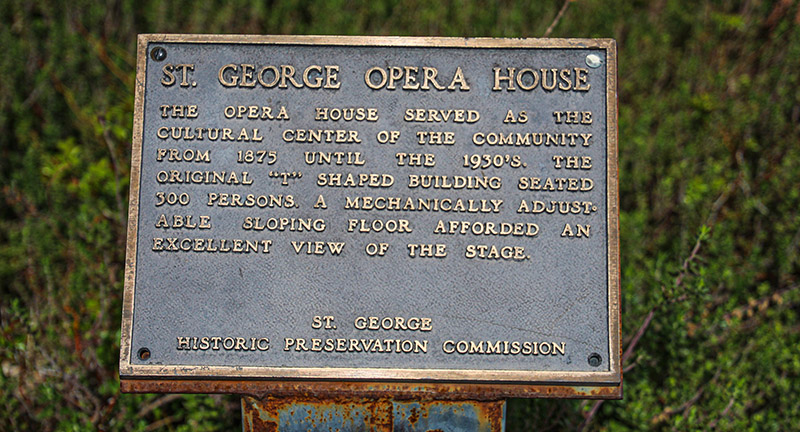
Commercial Buildings
Walking out of the Pioneer Courthouse parking lot, turn left (north) and begin climbing 100 East. The first building on the left is the Pioneer Museum. Turn left at the next street, 200 North.
Opera House
At the end of the block, before reaching Main Street, the St. George Art Museum and Opera House are seen on the left. The Opera House is the historic building, being built in 1875. Look for the year near the roof. It sat 300 people and served the community until the 1930s.
Mercantile Building
Turn left onto Main Street and head downhill towards the traffic light. Cross both Main Street and St. George Blvd. to walk south on the right side of Main Street.
The first building on the corner of Main and the Blvd is a new hotel built in 2019. The next building is historic and is currently occupied by the Bear Paw Café. This was originally the St. George Co-Op Mercantile Building that was built in 1876.
Bishop’s Storehouse
At 17 North Main, the Bishop’s Storehouse was built in 1887 to receive and store the offerings of LDS Church members that were to be distributed to the widows, the poor and the needy in town. It is currently a real estate office.
Thomas Judd’s General Store
At the end of the block, turn right onto Tabernacle Street. Across the street is the Tabernacle. We’ll talk more about this later.
We’ll walk a little further and, on the right, we pass by St. George’s oldest on-going business, Thomas Judd’s General Store. It was built around the 1890s. In 1911, the store was purchased by the Judd family. Today it serves as a candy and ice cream store.
Green Gate Village
Continuing west on Tabernacle Street, Green Gate Village is passed on the right, which is a collection of commercial buildings now, but originally were a lot of residences. There are about ten buildings located here.
Woodward School
At the end of the block, turn left and cross Tabernacle Street. Here, we enter the St. George town square. On the left is the Woodward School. The early settlers here put a high value on education and built this school in 1898. Today, it serves as administrative offices for the Washington County school district, and has some historical artifacts on display, inside.
Tabernacle
Walk across the park and begin heading to the left, back towards Main Street. A good view of the Tabernacle will be seen on the left.
The Tabernacle took 13 years to build and was completed in 1876. Its purpose is to hold community gatherings and provide a place of worship. With construction of the St. George Temple being complete the following year, and the Pioneer Courthouse already complete in 1870, by the late 1870s, the budding town of St. George was really starting to take shape, as you can see in this historic picture from about the turn of the century.
Dixie Academy Building
When you reach the sidewalk of Main Street, turn right. Soon, the St. George Children’s Museum is reached on the right.
This is the Dixie Academy Building. It was built in 1911. This was basically the beginnings of Dixie State University or DSU, which is now known as Utah Tech. Today, the university is located about a mile east of here and this building now serves as the St. George Children’s Museum.
Dixie Photo Shop
After looking at the Dixie Academy Building, turn around (180 degrees) and head back north up Main Street. When you reach Tabernacle Street, turn right crossing Main Street.
The first building of interest is the Dixie Photo Shop. This fine two story building became a business in the early 1920’s. It was built along the Arrowhead Trail, that would later become US highway 91, which was later moved a block north onto St. George Blvd a few years later, then replaced by Interstate 15 in the 1970s. Many important services were carried out at this building that really enhanced the lives of those who lived in St. George.
Electric Theater
The next building of interest down the street is the Electric Theater. It was built in 1911 and has 220 seats. Ownership changed hands several times over the last 110 years. It stopped showing movies in 1999. In 2013, the City of St. George purchased the Electric Theater and uses it for various activities, including plays, concerts and presentations.
At the end of the block, just past the Electric Theater, is another interesting historic commercial building. The date of the original structure is unknown, but it was owned and operated as the Nelson Mercantile until 1924. It changed hands and appearance a few times, then was restored to its original appearance in 1992.
County News Building – Return to Pioneer Courthouse
Head back to Main Street and turn right to head back up to St. George Blvd. Cross the Blvd. and turn right (east) towards the Pioneer Courthouse. There’s one more historic building to look at.
Most of the commercial buildings in this block were build in the 1960s. One building however was built as a saloon in the 1880s in the nearby mining town of Silver Reef. After the silver boom ended around 1890, it was moved here and became the County News Building. The Washington County News was printed here until around 1900. After that, this building housed several other businesses.
The building is difficult to spot while walking past the more modern movies. Refer to the Commercial Building Walking Tour video.
Residences
ddd
Map
To help walking tours, either use our interactive Google Map below or download our GPX file that points out the places covered in this tour.
Click here to download our GPX file of all the tour stops mentioned in the Triple Junction tour. View the stops using a GPS mapping app, such as Gaia GPS or Google Earth, so that you can navigate to each stop. Click the ad below to purchase Gaia GPS using our discount code which offers up to a 50% discount.
Learn more about our maps.
Support Us
Help us fill up our tank with gas for our next trip by donating $5 and we’ll bring you back more quality virtual tours of our trips!
Your credit card payment is safe and easy using PayPal. Click the [Donate] button to get started:
